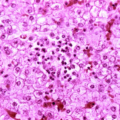Case example 6.13 on page 248 of our book, Thiamine Deficiency Disease, Dysautonomia and High Calorie Malnutrition, is the story of a child with the conventional diagnosis of juvenile rheumatoid arthritis. The case is so important that I want to discuss it in detail, pointing out the reasons and the rationale for the treatment that was used.
Juvenile Rheumatoid Arthritis: A Case Study
An-eight-year-old Caucasian girl was first examined for juvenile rheumatoid arthritis, a diagnosis made elsewhere. She had been born prematurely with a birth weight of 1.6 kg. Early development was normal and she was receiving high scholastic grades. Six months previously her right knee became swollen and stiff. Fluid was aspirated and she received an intraarticular injection of corticosteroid. The laboratory tests showed no systemic effect and culture of the synovial fluid was sterile. Three months later the same knee became swollen and the joint was reported to be warm to the touch and tender. Laboratory tests were again reportedly negative. Appropriate doses of acetylsalicylic acid (aspirin) were started, which she was unable to tolerate because of nausea.
The first clue here is the premature birth. It had long been known that there was a legacy for premature birth and this has been confirmed recently The second clue was that the laboratory studies were reportedly normal repeatedly, giving rise to speculation that this was an unusual example of juvenile rheumatoid arthritis. The third clue, unlikely as it may sound, was the report of high scholastic grades. A well-endowed brain requires more energy than a less well-endowed brain. The nausea is a symptom produced by the brain, meaning that the aspirin had sent a signal into it, implying undue sensitivity of the cells receiving the signal. That kind of hypersensitivity reflects mild brain oxygen deprivation (hypoxia) or pseudohypoxia (inefficient oxidation)
Other symptoms were constantly cold hands, recurrent abdominal pain with nausea, easy fatigue, and pallor. Stiffness in the joint was more marked in the morning. Sleep requirement was noticeably increased compared with her two siblings and she was described as persistently irritable and bad tempered. On examination she was normal for height and weight and looked pale. Filiform papillae on the tongue were prominent. The heart rate was 140 bpm and the blood pressure 120/66 mm Hg. Both legs were mildly cyanotic (dusky blue) and the feet cold to the touch. Dermographic stimulation (with a fingertip) produced obvious blanching, which was more marked on the right leg. The right knee was swollen with some patellar tap (indicating fluid in the knee joint) and the circumference of the left thigh was measurably greater than that of the right. A qualified dietitian reported that her nutrient intake was adequate and she was counseled. Two weeks later she developed some swelling in the left knee. Examination revealed facial flush with circumoral pallor, overactive heart, audible femoral pulse by auscultation, unpredictable deep patellar knee reflexes varying from nonreactive to double in nature and mild cyanosis of the feet and hands together with well-marked hippus of the pupils (light stimulation produced alternate dilatation and constriction). Laboratory studies revealed an abnormal TPPE in red cell TKA, elevation of serum B12 and moderately increased ratio of creatine to creatinine in urine. There are a lot of clinical clues here, many of which I had discovered from experience over many years.
-
-
- Increased sleep requirement. I had noticed that this was a reliable clinical test of energy deficiency. This has recently been confirmed .
- Cold hands, recurrent abdominal pain with nausea, easy fatigue, fast heart rate, cyanotic legs and cold Without going into details, these symptoms are all due to oxidative dysfunction in brain cells.
- Prominent filiform papillae on the tongue. These are part of the tongue surface structure. Although I do not know the mechanism, I have repeatedly observed this in children whose symptoms were resolved by the use of megadose thiamine. They look like little red spots because I assume that they are probably inflamed. The red spots disappear after the patient is reconstituted.
- Demographic stimulation with a fingertip. Both children and adults can show this phenomenon. In the wake of the stroking action of the fingertip, a blanching occurs, producing a white figure on the skin. I have assumed that this is a local reflex affecting skin capillaries due to changes in autonomic nervous system controls. It does not appear in biochemically healthy people.
- Flushed cheeks with circumoral pallor. This is something I have observed repeatedly in children affected by oxidative inefficiency of brain. This is reported in the medical literature as a typical appearance of streptococcal infection. My observations belie this and I think that it is simply a marker of stress and not unique to infection.
- Audible femoral pulse. By placing a stethoscope over the inguinal ligament, the pulse was clearly audible. It is a characteristic described in the symptoms and signs of beriberi. In an adult case of beriberi the pulse can be audible without the use of a stethoscope.
- Laboratory studies described. These are all typical of poor energy metabolism from thiamine deficiency.
-
Thiamine Treatment and Progression of Recovery
After informed consent of both the child and her parents, thiamine in the form of thiamine tetrahydrofurfuryl disulfide (TTFD), 150 mg per day, and a comprehensive high-potency multivitamin were started. TTFD is a synthetic derivative of allithiamine, a form of naturally occurring thiamine discovered in garlic. Its biologic action is that of thiamine but it has been found to have a greater biologic potency in animal studies and eventually in humans. Its action is that of megadose dietary thiamine by stimulation of energy production.
Two Months
Two months later it was reported that there was no change in her knees but that her disposition was improved. Body weight had increased by 1kg. Recurrent cyanosis and coldness of the feet were still present. The right knee was swollen and there was about 5° of flexion deformity. No patellar tap could be elicited.
Three Months
Three months later she reported the disappearance of pain and stiffness and her activity included running and riding a bicycle.
Seven Months
After seven months she reported full physical activity without pain or stiffness and great improvement in personality. She looked well. There was mild livid mottling of the skin in the legs. Blood pressure was 100/60 mm hg and heart rate was normal. Thigh circumference was still greater on the left, but no deformity or swelling was detectable in either knee. Red cell TKA had increased and the TPPE had fallen to 1.8%. The dose of TTFD was decreased to 100 mg per day. In addition to the physical improvements, there was noted improvement in personality and behavior. I would like to suggest that irritability and bad temper is usually considered to be the personality of a child in pain and it might be, however, my experience with bad temper in children without arthritis is that the personality changes dramatically when they receive megadose thiamine. The expression of normal personality is a function of a healthy brain, dependent on cellular energy.
A Relapse
In the next few months it was revealed that there had been some stresses within the family, although their nature was not discussed, and eight months after decreasing the dose of TTFD there was found to be some synovial effusion and swelling in the left knee. Urinary ratio of creatine to creatinine had again increased. The dose of TTFD was increased to 200 mg/day. Four months later TTFD was replaced by thiamine hydrochloride, 300 mg per day. General health was good and she was asymptomatic. Urinary creatine/creatinine ratio had decreased. At the age of 12 years when last examined, she was completely well and free from symptoms. It should be noted that the re-emergence of her symptoms was in direct relationship to the additional energy requirement brought on by the family stress. Stress is defined as any form of environmental attack requiring an energy dependent adaptive response, whether this is a prolonged mental struggle, trauma or infection. The reappearance of joint pathology suggests that the family stress had siphoned off adaptive energy for brain use: hence the decision to increase the dose of TTFD. Additionally, a higher than normal urinary ratio of creatine/creatinine is evidence of an energy deficit. When the high ratio decreased in this patient, it indicated an improvement in energy metabolism
Points of Consideration
A study of 225 juvenile idiopathic arthritis cases (JIA) and 138 playmate-matched controls has been reported. Compared to the controls, preterm delivery was associated with JIA (3). Premature infants constitute a risk group for thiamine deficiency. Thiamine diphosphate (TDP) was determined in whole blood in the first days of life and approximately every two weeks in 111 premature infants. TDP concentrations showed an age-dependent decline. Obviously, this raises the question of the long-term legacy because this patient was eight years of age. Without going into the details of the laboratory study, the effect of adding thiamine pyrophosphate in showing an acceleration in red cell transketolase activity proved that there was indeed thiamine deficiency. Glucose metabolism not only provides energy for physical activity that also mediates a variety of physiological processes through the formation of complex signaling networks. Recent studies have indicated that glucose metabolism plays an important role in the pathogenesis of rheumatoid arthritis. Since thiamine plays a vital part in glucose metabolism, it is not too big a jump to see why megadoses of thiamine had this remarkable effect. There is much evidence that energy metabolism plays an enormously important part in the etiology of many if not all diseases. Perhaps the use of TTFD should be explored in the treatment of other inflammatory diseases. The length of treatment, measured in many months, is a very strong indication that this was far from being a simple dietary phenomenon. There may have been a fundamental genetic abnormality, but it raises the question whether thiamine deficiency during pregnancy can give rise to a prolonged legacy that interferes eventually with the growth of the child.
We Need Your Help
More people than ever are reading Hormones Matter, a testament to the need for independent voices in health and medicine. We are not funded and accept limited advertising. Unlike many health sites, we don’t force you to purchase a subscription. We believe health information should be open to all. If you read Hormones Matter, like it, please help support it. Contribute now.
Yes, I would like to support Hormones Matter.
Photo by Lucaxx Freire on Unsplash.
This article was published originally on September 12, 2019.
Rest in peace Derrick Lonsdale, May 2024.
















Hi and thank you very much for this article. It has been a guiding light for me as I try to treat undifferentiated arthritis/rheumatoid arthritis with TTFD. I’m now in my 2nd month after a couple months on HCL. I am up to 400mg and wanting to try more. I’m wondering how long I should persist in this experiment before I go back to my rheumatologist? I had many ‘dysautonomia’ symptom since I was a child including raynaud’s, sweaty hands and feet, flushed cheeks. My joint issues have been quite serious for ~5 years and I’ve been medicating with anti-inflammatories as most other treatments were not recommended yet as I’ve been pregnant twice and breastfeeding my girls. Between the two pregnancies I actually had my wisdom teeth out and that resulted in a drastic reduction of symptoms (no morning stiffness, joint issues only in one ankle and my jaw, and a normal ESR blood test). That helped me to feel that stress from infection really can contribute to so-call autoimmunity. But weeks after the birth of my second child I had a serious flare. Now that I’ve stopped breastfeeding and can focus on my health, I want to get to the root but also feel worried about letting the autoimmune condition go too long without treatment. Also, I live in the Philippines and while I have cut back on white rice, I am still eating it. How important would you say it is to adopt a thiamine saving diet? So far, I feel the effect of the TTFD as I am able to lessen my NSAID requirement but I’m still hobbling around in the morning, can’t turn my neck fully etc. I would like to regain mobility in my joints without methotrexate! Thanks again for all you do!
Hi Dr. Lonsdale, thank you for creating this amazing blog. I had a long list of symptoms after suffering from a very high fever due to h3n2 flu. I am getting relief from ttfd and it’s been 3 months since I started ttfd, did thiamine hcl for 2.5 months before starting ttfd. I am getting better but there is one symptom which is not improving and it is the constant shakiness in my spine. I feel it whenever I am in sitting and lying position, I don’t notice it when I go for walks.
Is it muscular – the muscles around the spine or do you feel as though the spine itself is moving or both?
Hello! My son was diagnosed with oligoarticular JIA, are there any other suggestions that you have, or would this be the main one? Thank you
I definitely think that there allithiamine deficiency could have been a factor, worth noting that A LOT of juvenile arthritis cases have an underlying “tick borne” causing agent. Parenthesis because this can be caused by any biting insect. I’m referencing lyme strains (many that cannot yet be and are not accurately tested for), Babesia, Bartonella, Ehrlichia, Rocky Mountain Spotted Fever and the list goes ON and ON. I’m speaking from personal experience, it taking literally a decade to get a diagnosis for these and then some. I was diagnosed with so many other things prior; Fibromyalgia, Chronic Fatigue Syndrome, POTS, Raynauds, IBS, and that just scratching the surface.
These types of bacteria utilize certain vitamins to survive which is what causes the deficiency. Caution should be taken as supplementing can actual feed the bacteria more, but obviously the body needs these nutrients as well. I wanted to mention this so people are aware.
I too had this problem with severe nutrient depletion despite adequate intake. Best to all!
I am going to try to give you my explanation. Fibromyalgia, chronic fatigue syndrome, POTS, Reynaud’s disease and IBS are all evidence of energy failure in the brain, although I doubt that you will accept this as the truth. Invading microorganisms are, if you will, all forms of physical stress to which we have to adapt. The adaptation depends on a complex of defensive mechanisms including the immune system and we either win the war or lose it. If you win the war you may never know that you have been attacked because the defense is automated. If on the other hand there may be overt evidence of a war taking place and we call that an illness. We now know that inflammation is controlled by the brain through the vagus nerve that sends messages to the spleen where part of the defense process is organized. Therefore your defense depends on an adequate energy supply in the brain and could explain why thiamine deficiency might be the underlying cause of your problems.
When thiamine is the only hammer you have everything begins to look like a nail. Boron deficiency or its depletion might be considered a factor here also
Totally agree with you. I believe bone to also be a storage facility for extra minerals when needed. This adrenaline for fight or flight makes little sense when looked at objectively, and osteocalcin make way more sense, and so she relapsed because we rely on bones for stress. So she still had not had a chance to properly replenish boron when the stress came about.
https://www.sciencedirect.com/science/article/pii/S1550413119304413 Mediation of the Acute Stress Response by the Skeleton
Help??
I’ve tried supplementing with just the 100mg of benfotiamine first thing in the morning. Every time I take it I have severe insomnia that night. What could be going on? I take other Sulphur containing supplements such as msm and taurine and I don’t have this issue with them.
I’m feeling a little desperate here, I know that thiamine is needed but I can’t handle not sleeping every night.
Have you tried cutting the dose in half or a quarter and starting with 25mg for a few days or every other day and titrations up until your body gets acclimated with it? Also it seems that allithiamine is a better option this is a powder in a capsule so you can pour it out, that’s what I did. Hope this helps!
Becky is quite right. Read about paradox on this website. There is no gain without pain